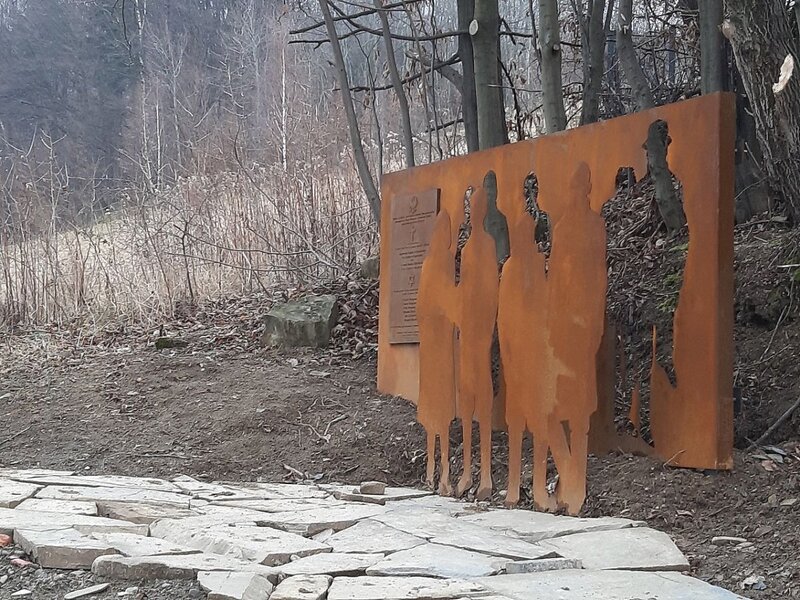
“They were on the brink of starvation, just like we were. The Jewish women embroidered tablecloths that mum sold, and they also gave Mum their clothes for sale. They lived in the attic, and cooked with us, downstairs. Where they washed and did the washing I don’t remember, I suppose it was also up in the attic”, Kunegunda, daughter of Agnieszka Rumin murdered for aiding Jews, reminisces. The Germans killed a total of four people in the Sądecczyzna region in 1944 for aiding a group of people from the Kaufer, Neugröschel and Schreiber families.
Oleńka, the daughter of Ruth and Abek, was born in hiding. “Everyone was afraid that the presence of the child could be a giveaway, as her crying could break the secrecy of the hiding place”, Stanisława Korzec, Agnieszka’s daughter recalls. A decision was reached to take the girl to a childless couple. The child probably survived the war however, despite searching the available sources, her future fate remains unknown.
They lived in the attic
During the German occupation, Józef Ludwik Borek resident of Mystków, a village situated several kilometres away from Nowy Sącz, took a group of Jewish fugitives into his home. He was helped by Jakub Tokarz from Ptaszkowa. With time, six people from the group moved to Maria Górka’s farmstead, which the locals called “Górecka”. There were still at least two people staying at Józef Borek’s. In a while the Jews staying at “Górecka’s” left and moved to a new hideout. Probably late in 1942 or early in 1943, Mojżesz Kaufer with his wife Blimkaand mother-in-law, his brother-in-law Aba (Abek) Schreiber with his fiancée Rutaand her brother Chaim (Heniek) found shelter in the home of Agnieszka Rumin in Popardowa. Agnieszka knew the Kaufers from before the war. They hailed from Zawada and traded in cattle. At the time, her husband, Marcin Rumin, was employed by Kaufer.
The Rumins with their seven children lived in poverty in a poor wooden house. When the Jews arrived, Marcin Rumin did not live there. Quite likely he had been deported as forced labour to the Reich back in 1940. “The house we lived in stood off the beaten track, in the woods. It consisted of a single room, with an attic above it. The Jews were hidden in the attic. In the evening they would come downstairs to the room, and then me and my siblings sat in the windows making sure that no one approached”, Józef, son of Agnieszka Rumin, reminisced many years later. In winter, one of the Jews taught the children to read and to write.
As snow fell at night
One night, in late winter and early spring in 1944, Abek with Kaufer visited the farm of the peasant woman where they had been hiding earlier and took a heifer and two rabbits. A theft was very likely perpetrated two weeks later: 200 kilo of potatoes were stolen. After the war, witnesses testified that the thieves were Jews, however it must not be ruled out that they had left what they had owned with a woman who had given them shelter earlier, and only took back what was theirs.
“Fresh snow fell that night, and mother followed the footprints up to Popardowa”, the son of Maria Górka recalled. According to the available sources, following the footsteps left by the perpetrators of the theft in the snow, the housewife and an acquaintance reached the house of the Rumins. A quarrel started. The Jews are believed to have promised the woman that, should they survive the war, they would compensate her for what she had lost. Probably they gave her clothing as immediate compensation, and the aggrieved woman is believed to have promised that she wouldn’t inform the Germans. However, she soon changed her mind and informed the occupying authorities about the theft that had taken place.
In March 1944, a group of several German officers surrounded the house of the Rumins and conducted an on-site inspection. Neither Agnieszka Rumin nor her eldest son Jan were at home at the time. The witnesses of the massacre were the small Rumin children.
“I was at home when the Germans arrived”, Kunegunda recalled. “They started shooting up, towards where the Jews were staying; then two of them walked into the corridor and made them come downstairs. The women came down first and Abek attacked one of the Germans to take away his gun. Then another German shot him dead. As Kaufer did not come down, the Germans went upstairs, shot him dead, and threw him down. I saw all that through the open door. They made the surviving Jews, that is three women and a boy, leave the house. They made them all lie on a mound next to the building. The women lay down, and the boy fled into the forest, yet Germans shot a burst of rounds at him, and the boy fell. They killed all the three women. I saw it through the window.”
All the hiding Jews were shot. At the time, the children of Agnieszka Rumin were guarded by one of the German officers. Then, on the order of the Germans, the bodies of the murdered were thrown into a pit dug by thelocals next to the farmhouse.
Repressions for aiding
Despite being warned, Agnieszka Rumin and her son Jan returned home. They were soon arrested, and murdered for hiding Jews. The German officers also found the Jews staying at Borek’s. Their host tried going into hiding, yet he was found and executed. Also Jakub Tokarz from Ptaszkowa was killed. The news of the penalties for aiding Jews during the occupation echoed among local rural communities and reinforced the efficiency of the machine of destruction. The intention of the occupying forces was to have Jewish refugees considered a huge threat.